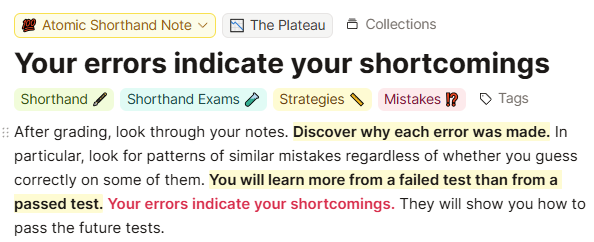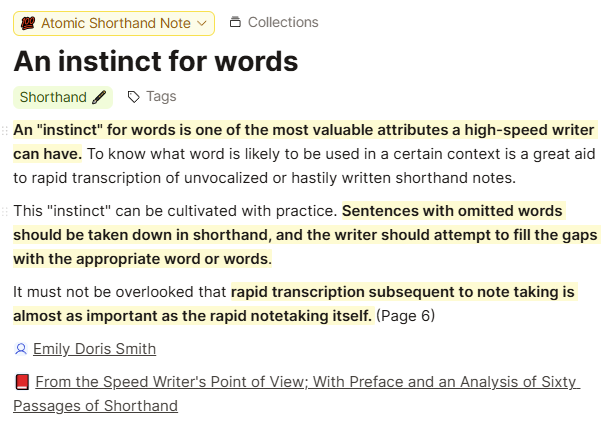LLTT Newsletter - July 2025

LLTT - July 2025
Welcome back!
Your Notes Are Talking: But What Are They Saying?
The students who transcribe only their best work learn slowly. The students who carefully examine their difficult sessions learn fast, because that's where the most useful information lives.
Here's what most Teeline students won't admit: they avoid looking deeply at their own notes.
Picture this: You scribble frantically through a dictation passage, feeling like you're drowning in words you can't keep up with. When it's over, you glance down and think ‘complete disaster.’ So you flip to a fresh page and try again, hoping somehow the next passage will magically be better.
This is exactly backwards. That ‘disaster’ on your page isn't evidence of failure, it's a goldmine of information about your shorthand. But almost no one bothers with proper transcription work because it requires facing exactly where you stand right now, not where you hope to be.

Unless you take an active part in identifying your error patterns, you're not just missing opportunities to improve, you're likely reinforcing problems without realising it. Every time you write an outline or grouping two or three different ways and don't notice, you're training inconsistency. Every outline you can't read back represents a fixable problem, but only if you're willing to see it. It has been said that ‘Allowing your eye to become accustomed to improperly made outlines will invariably cause your hand to make them likewise.’
When properly done, the time you spend on transcription revision shows you how you respond to, and write, under pressure.
When you attempt a higher speed, do your normally careful letter proportions fall apart? Do you unconsciously write ‘this’ and ‘those’ the same way? Do your double-length strokes for ‘TR’ and ‘DR’ become indistinguishable from a regular T and D? Do you hesitate more than usual on common phrases like ‘on the other hand’ that you know perfectly well in theory?
Your notes also reveal less obvious problems: Are you carrying words, lagging so far behind the dictation that you're relying too much on memory instead of writing? Or are you editing while writing, perhaps mentally checking previous outlines instead of focusing on what's being said now?
You must keep in mind at all times that you can only fix what you can see, but you can only see it by honestly examining what you've actually written.
The Truth Your Notes Tell
The students who take the time to transcribe their notes (really transcribe them) and wrestle with every unclear outline discover something remarkable. Their ‘disasters’ are often 70% readable. In other words, your ‘feelings’ during a dictation can be notoriously unreliable. The only truth is what's actually on the page.
When you commit to regular transcription revision, you'll start noticing specific patterns. Maybe you write ‘difference’ when you mean ‘difficult.’ Or perhaps your ‘X’ blends could benefit from some remedial work. Do your single-length Ms look too much like your double-length MR blends?
Each discovery is a victory, not a defeat. Each pattern you identify is something you can then fix through better outline formation, consistent positioning, or simply revisiting the theory.
The goal is achieving 98-99% readability for your stroked words. Anything less and you're building speed on a foundation that will collapse under pressure.
The Context Advantage
Here's something liberating about Teeline: it's designed to be somewhat ambiguous. Words like ‘fit,’ ‘fat,’ ‘fate,’ and ‘fight’ are written the same way, but the context of the passage should make it clear. Most shorthand systems work this way by training you to infer meaning from partial information, just like you do when reading someone's hasty handwriting. And you can get better at it.
Students who embrace transcription learn to work with ambiguity more confidently. They develop the skill of using sentence context to decode unclear outlines. But they also learn to recognise when context may not be enough. For example, when poor positioning has made ‘was’ look like ‘always,’ or when ignoring a Teeline principle creates genuine confusion.

Real Speed vs Fake Speed
Most students think speed means moving their hand faster. But real speed means both writing efficiently and reading back accurately.
Many students ‘fail’ not because they lack speed, but because they cannot write common words clearly enough to transcribe them. A student who can write at 80 wpm and transcribe everything they've written is infinitely more capable than someone who scribbles at 120 wpm but can't read half of it back.
The temptation to push for speed without clarity is what is called a ‘magnificent falsity.’ It feels like progress but actually corrupts your writing style and can even cost you previously gained speed. The students who focus on transcribing common English words (just the everyday words that typically make up 80% of any text) build genuine, useable speed. They're training their brain to recognise the patterns that actually matter.
The Reality
Students who regularly transcribe discover they often achieve more than they thought. What felt like missing ‘everything’ still turns out to be capturing the essence of most sentences. This happens because your hand can keep writing useful shorthand even when your conscious mind feels overwhelmed. But you can only get this reassuring feedback if you do the transcription work. Without it, you're left with anxiety and guesswork about your real capability.
The Path Forward
Make a decision to give serious transcription work a try. Start transcribing immediately after each dictation whilst it's fresh in your mind. Circle outlines you struggle with, but be somewhat generous with yourself about what counts as ‘unreadable.’ If you got the gist even with an imperfect outline, that's still progress worth acknowledging.
Keep a list of your specific challenge areas. Never refer to yourself as ‘hopeless at shorthand’ but rather, ‘I need more on my TR blends’ or ‘I confuse 'so' and 'also' when writing quickly’ or ‘My positioning gets sloppy when I'm tired, making T and D words hard to distinguish.’
Create a ‘hesitation words’ list (words that make you pause during dictation) and practise them until they become automatic. It is true that in shorthand, you are only as fast as your ability to write your slowest word.
Notice where you consistently struggle. Is it technical terms? Long sentences? Certain speeds? All are fixable but you need to know where to start so you can prepare more effectively and build your confidence.
As we mentioned earlier, the students who transcribe only their best work learn slowly. The students who carefully examine their difficult sessions learn fast, because that's where the most useful information lives.
Your notes are trying to tell you exactly what you need to know to improve. They're showing you not just your mistakes, but your successes which you didn't even notice. They're revealing patterns that, once seen, become easier to fix.
Your shorthand skills are probably stronger than you realise. Transcribing your notes will reveal this truth. And if gaps do exist, then identifying exactly what needs improvement will help move you ahead. But you must trust the process. Your worst notes are often your best teachers.
What holds you up the most? We want to hear from you.
Be sure to visit us at the LLTT Website, YouTube, Facebook, Instagram, Quizlet and Soundcloud.
If you’re looking for Teeline reading practice, Skill Building Through Reading 📗 - is available for purchase online.
Much work (and ❤️!) has gone into this 48 page, 6x9 softcover book:
Five 5️⃣ carefully selected passages: Improve your sight 👁️ recognition of outlines and word groupings.
Dual Format: Each passage includes both printed Teeline and the longhand ✍️ transcription.
Proven Learning Approach: Reading printed 🖨️ shorthand is a method long-favoured by skilled practitioners.
Whether you're a student, journalist, or professional seeking to improve your note-taking, this book will be a valuable addition to your Teeline learning resources.
To order, please visit the book’s landing page or respond to this email with any questions.
If you find this newsletter helpful, please help us spread the word and forward to a friend!
A Parting Thought


Add a comment: